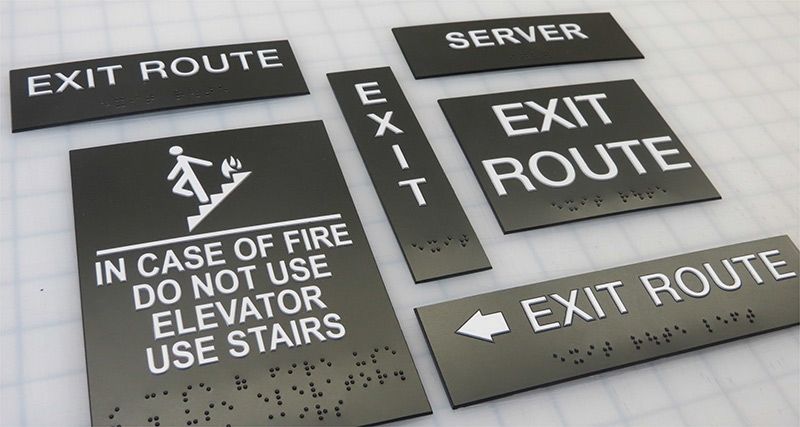ADA Signs: Ensuring Access and Conformity in Public Spaces
ADA signage plays a vital role in ensuring access and compliance within public areas, significantly adding to a comprehensive environment for individuals with impairments. As we check out the subtleties of ADA signs, from responsive functions to create details, it's critical to consider exactly how these aspects integrate to promote the civil liberties of all customers.
Relevance of ADA Signs
In modern society, the significance of ADA signs expands past simple conformity with lawful requireds to personify a dedication to inclusivity and availability for all individuals. These signs are important in producing environments where individuals with handicaps can browse public areas with the exact same convenience and self-reliance as those without impairments. By offering standard and clear info, ADA signs guarantees that everyone can access centers, services, and information without obstacles.
The value of ADA signage depends on its capacity to boost the top quality of life for people with impairments by advertising equal accessibility. It removes the obstacles that could otherwise hinder their capability to get involved totally in area life. In addition, these indications work as visible indicators of a company's dedication to variety and equality, mirroring more comprehensive social values that promote the rights and self-respect of all individuals.
Moreover, ADA signage plays a vital role in public security. By directing people to departures, restrooms, and other crucial facilities, it makes sure that all individuals, despite physical capacity, can leave safely during emergency situations. In summary, ADA signage is not simply a regulative need but a powerful tool for cultivating a inclusive and equitable society.
Secret Components of Conformity

Positioning is crucial; indicators must be installed in locations that are obtainable and quickly visible. Generally, signage ought to be mounted between 48 and 60 inches from the ground to ensure accessibility for both standing and wheelchair users. Responsive components, such as Braille, are crucial for people with visual impairments, providing crucial information in a non-visual layout.
High-contrast shades between the text and history are needed to boost readability for people with low vision. The ADA mandates certain comparison proportions to guarantee clarity. Additionally, character dimension is a crucial consideration, with minimum elevation requirements dictated by the viewing range to guarantee readability from various angles.
Layout Considerations for Accessibility
Creating easily accessible signage requires a thorough technique to ensure it satisfies the needs of all customers, especially those with specials needs. This includes considering numerous design components that enhance readability and functionality. Key aspects include the option of font, shade comparison, and tactile features. Typefaces must be sans-serif, with clear and simple letterforms, to facilitate simple analysis. The size of the message is similarly critical, with ADA guidelines advising a minimum height based upon watching distance to ensure clarity.
Contrasting shades in between message and background are necessary for presence, especially for people with visual impairments. Additionally, Visit Website tactile aspects, such Web Site as Braille and elevated personalities, are crucial for individuals who are blind or have low vision.
Furthermore, the positioning of signage plays a significant function in availability. Indications ought to be set up in places that are quickly reachable and unobstructed. Ensuring that signage is mounted at ideal elevations and angles allows all users, consisting of those utilizing wheelchairs, to engage with them successfully.
Common Blunders to Prevent

An additional common mistake is the inaccurate positioning of signage. ADA standards specify specific height and area demands to ensure that indicators are easily noticeable and reachable by all redirected here individuals, consisting of those making use of wheelchairs. Disregarding these guidelines not just hinders accessibility however additionally runs the risk of non-compliance with lawful standards.
Furthermore, insufficient comparison between text and history is a frequent oversight. Sufficient comparison is important for readability, especially for individuals with low vision. Designers occasionally choose colors that are aesthetically attractive but lack the needed comparison, rendering the text tough to recognize.
Lastly, some designers stop working to integrate tactile aspects, such as Braille, which are crucial for individuals that are blind. Leaving out these features not only leads to non-compliance with ADA guidelines however additionally restricts gain access to for a section of the population that counts on tactile info.
Future Trends in Signage
Improvements in technology and increasing awareness of inclusivity are shaping the future patterns in signs layout. As culture comes to be extra aware of varied demands, the integration of wise innovations into signage is acquiring traction. Digital signage, for instance, is evolving to include real-time updates and interactive functions, which can be important in offering dynamic information in public spaces. These indicators usually include touch displays or gesture-based controls, allowing users to navigate material customized to their particular requirements.
Another arising trend is the use of augmented fact (AR) to improve individual experience. AR-enabled signage can overlay electronic information onto the physical atmosphere, providing aesthetically impaired individuals with auditory or haptic responses. ADA Signs. This innovation not only enhances accessibility however also produces an interesting experience for all individuals
Sustainability is additionally a substantial element affecting signage patterns. Environmentally friendly products and energy-efficient lights services are being focused on to line up with international environmental goals. Advancements in materials science are leading to the growth of even more durable and weather-resistant signs.
Final Thought
ADA signage plays a crucial duty in guaranteeing ease of access and compliance within public areas by integrating responsive aspects, high-contrast shades, and critical positioning. The adherence to ADA standards not only facilitates safe navigation for people with handicaps yet also symbolizes an organization's dedication to diversity and inclusivity. By avoiding usual blunders and welcoming future fads, public rooms can proceed to progress these worths, making certain that the civil liberties and dignity of all individuals are respected and upheld.
ADA signage plays a vital duty in ensuring availability and compliance within public spaces, substantially adding to an inclusive environment for individuals with handicaps. As we discover the subtleties of ADA signage, from tactile features to design intricacies, it's crucial to take into consideration just how these aspects coalesce to copyright the civil liberties of all individuals.In modern-day culture, the importance of ADA signs extends past mere compliance with lawful mandates to personify a dedication to inclusivity and ease of access for all individuals. By giving clear and standard details, ADA signage ensures that every person can access facilities, solutions, and info without barriers.
ADA signs plays a vital duty in assuring access and compliance within public rooms by integrating responsive aspects, high-contrast shades, and calculated placement. (ADA Signs)